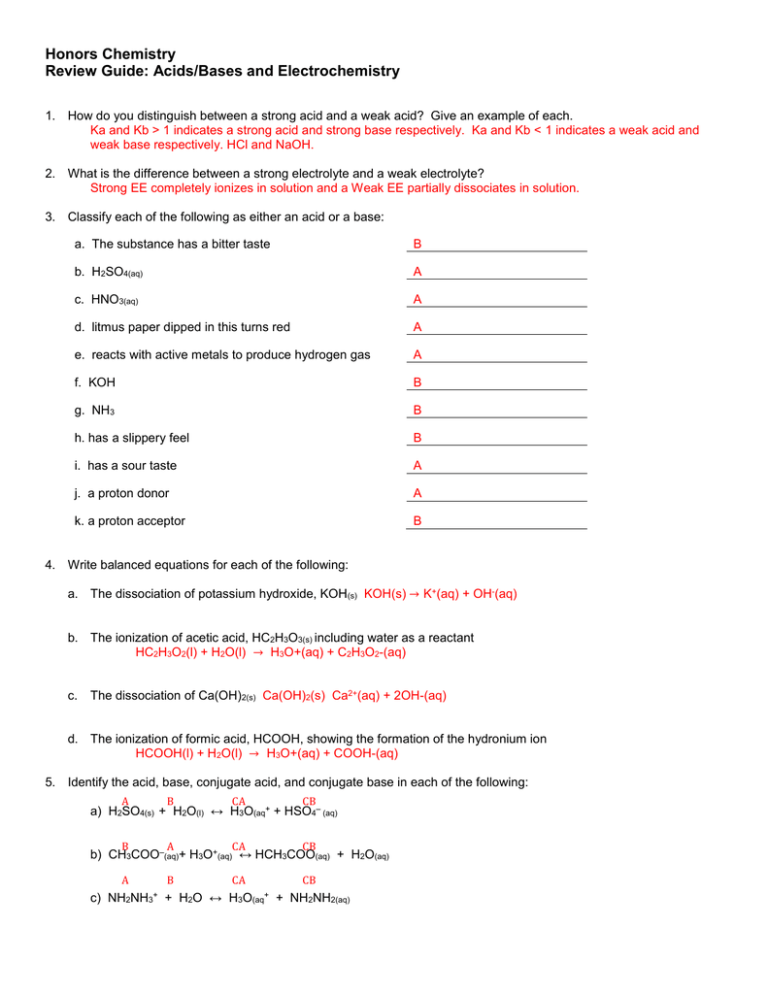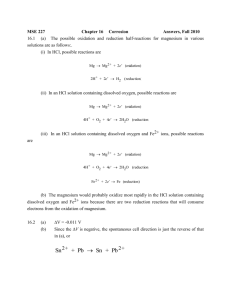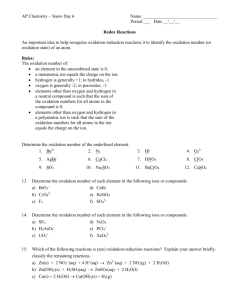Honors Chemistry Review Guide: Acids/Bases and Electrochemistry
advertisement

Honors Chemistry Review Guide: Acids/Bases and Electrochemistry 1. How do you distinguish between a strong acid and a weak acid? Give an example of each. Ka and Kb > 1 indicates a strong acid and strong base respectively. Ka and Kb < 1 indicates a weak acid and weak base respectively. HCl and NaOH. 2. What is the difference between a strong electrolyte and a weak electrolyte? Strong EE completely ionizes in solution and a Weak EE partially dissociates in solution. 3. Classify each of the following as either an acid or a base: a. The substance has a bitter taste B b. H2SO4(aq) A c. HNO3(aq) A d. litmus paper dipped in this turns red A e. reacts with active metals to produce hydrogen gas A f. KOH B g. NH3 B h. has a slippery feel B i. has a sour taste A j. a proton donor A k. a proton acceptor B 4. Write balanced equations for each of the following: a. The dissociation of potassium hydroxide, KOH(s) KOH(s) → K+(aq) + OH-(aq) b. The ionization of acetic acid, HC2H3O3(s) including water as a reactant HC2H3O2(l) + H2O(l) → H3O+(aq) + C2H3O2-(aq) c. The dissociation of Ca(OH)2(s) Ca(OH)2(s) Ca2+(aq) + 2OH-(aq) d. The ionization of formic acid, HCOOH, showing the formation of the hydronium ion HCOOH(l) + H2O(l) → H3O+(aq) + COOH-(aq) 5. Identify the acid, base, conjugate acid, and conjugate base in each of the following: A B CA CB B A CA CB A B CA CB a) H2SO4(s) + H2O(l) ↔ H3O(aq+ + HSO4– (aq) b) CH3COO–(aq)+ H3O+(aq) ↔ HCH3COO(aq) + H2O(aq) c) NH2NH3+ + H2O ↔ H3O(aq+ + NH2NH2(aq) 6. For each of the following bases, write the formula for its conjugate acid; for each acid write the formula of the conjugate base. Base Conjugate Acid Acid Conjugate Base I– HI HClO4 ClO4SO32– HSO3H2S HSPO43– HPO42HCO3– CO32– C2H3O2 HC2H3O2 H2SO4 HSO4- 7. What is the difference between strength of an acid and concentration of an acid? acid strength refers to the % ionization of the acid and concentration is a measure of the moles/L of the acid 8. What is a conjugate acid? The species that is created when the base gains a proton (H+). 9. What is a conjugate base? The species that is created when the acid loses a proton (H+). 10. Write out the chemical equation for the self-ionization of water. 𝐻2 𝑂(𝑙) + 𝐻2 𝑂(𝑙) ⟶ 𝐻3 𝑂(𝑎𝑞) + 𝑂𝐻 − (𝑎𝑞) 11. Write out the dissociation constant for #10, where Kw= 1.0 x 10-14 1 × 10−14 = [𝐻 + ][𝑂𝐻 − ] 12. If the hydrogen ion concentration is 1x10-5, what is the pH of the solution? pH=-log[H+] ; 5 13. If the hydroxide ion concentration is 1x10-12, what is the pH of the solution? pOH=-log[OH-] = 12; pH=14-12= 2 14. If the hydrogen ion concentration is 8.5 x 10-3, what is the pH of the solution? pH=-log[H+] ; 2.07 15. If the hydroxide ion concentration is 2.8 x 10 -12, what is the pH of the solution? pOH=-log[OH-] = 1.55; pH=14-11.55= 2.45 16. If the pH is 12.75, what is the concentration of hydrogen ions? 10−12.75 = 1.78 × 10−13 M 17. If the pH is 11.63, what is the concentration of hydroxide ions? 10−11.63 = 4.3 × 10−3 𝑀 18. What does the term oxidation mean? species losing an e19. What does reduction mean? species gaining an eFor each reaction below, identify the species oxidized, the species reduced, the oxidizing agent, the reducing agent, the oxidation half reaction and the reduction half reaction. Use the table to record your answers. 20. Mg + 2HCl ® MgCl2 + H2 21. 2Fe + 3V2O3 ® Fe2O3 + 6VO 22. Cu + 2AgCl ® CuCl2 + 2Ag 23. Zn + 2HNO3 ® Zn(NO3)2 species oxidized species reduced + H2 reducing agent oxidizing agent oxidation half-reaction ® Mg2+ + 2e- reduction half-reaction 2H+ ® H2 + 2e- 20 Mg HCl 21 Fe V2O3 2Fe 22 Cu AgCl Cu ® Cu2+ + 2e- 2Ag+ +2e- ® 2Ag0 23 Zn HNO3 Zn ® Zn2+ + 2e- 2H+ + 2e- Mg HCl Mg ® Fe+32 + 6e- 3V+32 + 6e- ® 6V+2 ® H2 24. When the following pairs of elements are reacted, indicate which element will undergo oxidation and which element will undergo reduction based on each element’s electric potential (standard reduction potential). Pair Mg and Li Oxidation Li Reduction Mg Pair Ni and Pb Oxidation Ni Reduction Pb Zn and Cu Zn Cu Na and Cu Na Cu BE ABLE TO DRAW AND LABEL A VOLTAIC CELL AS WELL AS AN ELECTROLYTIC CELL 25. Write the half reactions for both the oxidation and the reduction of water and then the overall. Oxidation: 2H2O ⟶ O2 + 4H+ + 4eReduction: 2(2H2O + 2e- ⟶ H2 + 2OH-) Overall: 6H2O ⟶ 2H2 + O2 + 4OH- + 4H+ 2H2O ⟶ 2H2 + O2 26. For the following redox reactions, identify the charges of each species, write the oxidation and reduction halfreactions and determine the net voltage. a) Fe + 2AgNO3 ⟶ Fe(NO3)2 + 2Ag 𝑬𝟎 Ox: Fe⟶ Fe2+ + 2e- -.44 V Red: Ag + e- ⟶ Ag+ 0.80 V = 0.80 + .44= 1.24 V 𝑬𝟎𝒄𝒆𝒍𝒍 b) 2AgCl ⟶ 2Ag + Cl2 𝑬𝟎 Ox: Ag⟶ Ag+ + e- 0.80 V Red: Cl2 + 2e- ⟶ 2Cl- 1.36 V 𝑬𝟎𝒄𝒆𝒍𝒍 -1.36 + .80 = -0.56 V c) Cu(NO3)2 + Zn ⟶ Cu + Zn(NO3)2 𝑬𝟎 Ox: Zn⟶ Zn2+ +2eRed: Cu2+ + 2e- ⟶ Cu -0.76 V 0.34 V 0.34 + 0.76 = 1.1 V 𝑬𝟎𝒄𝒆𝒍𝒍 27. In the electrolysis of KCl(aq) Both the K+ and H2O will be near the ( H2O Both the CI and H2O will be near the (+) electrode. Which chemical is more likely to be oxidized? H2O Write the reactions at each electrode and the overall reaction: Cathode: 2(2H2O + 2e- ⟶ H2 + 2OH-) Anode: 2H2O ⟶ O2 + 4H+ + 4eOverall: 6H2O ⟶ 2H2 + O2 + 4OH- + 4H+ 2H2O ⟶ 2H2 + O2 28. In the electrolysis of Zn(NO3)2(aq) Both the Zn+ and H2 ____ Both the NO3 and H2O will be near the (+) electrode. Which chemical is more likely to be oxidized? ____ Write the reactions at each electrode and the overall reaction: Cathode: 2(Zn2+ + 2e- ⟶ Zn) Anode: 2H2O ⟶ O2 + 4H+ + 4eOverall: 2Zn2+ + 2H2O⟶ 2Zn + O2 + 4H+








